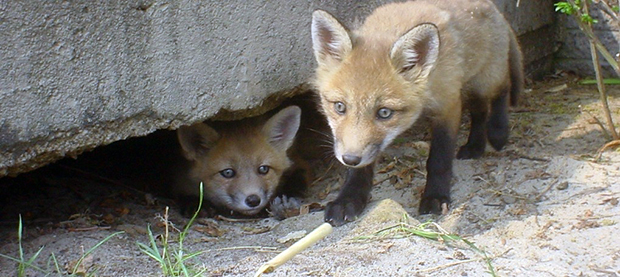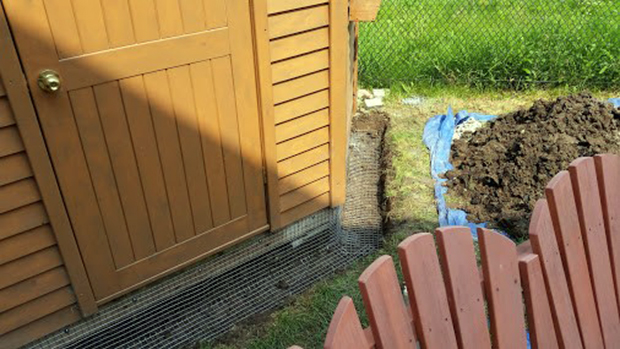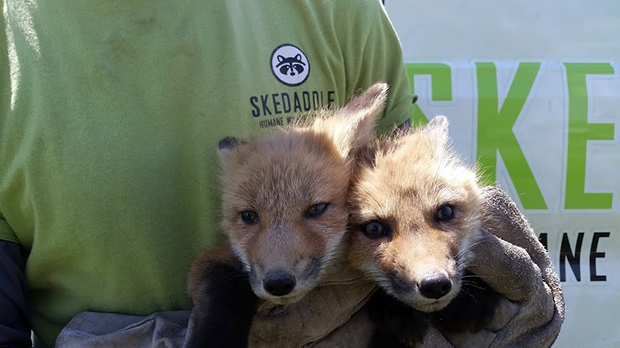Skedaddle Humane Wildlife Control has been receiving calls from homeowners in Montreal, Hamilton and Oakville who are concerned about seeing foxes in their neighbourhood. This is actually not unusual. Foxes commonly live in close proximity to human residences and communities where they can find plenty of food, water, and shelter. Urban foxes frequently inhabit yards, parks, and golf courses, especially areas that are near suitable, undeveloped habitats.
The only time you should be concerned about foxes is if they look mangy or aren’t acting scared of humans. There is a fox strain of rabies, so if you believe a fox is acting strangely it is best to avoid it and call the Ministry of Natural Resources. The fox strain of rabies was recently confirmed in Perth County, Ontario.
There are many different types of foxes, and they are the most widespread species of wild dog in the world. Foxes live just about everywhere – in the rural areas in the country, cities, forests, mountains and grasslands.
The most common foxes in Ontario are red foxes. They are widespread across Southern Ontario and throughout all the provinces and territories of Canada. Red Fox is the common name for these animals however, not all of them are actually red, as there are several colour combinations seen. The most common colour is deep red, but lighter and darker animals are often seen, with some being brown and almost black.
Male foxes are known as “Dogs” and females as “Vixens” and usually, but not always, have only one mate. Fox young are called “Cubs” or “Kits”. A group of foxes is called a skulk or leash.
Foxes reproduce once a year. Peak of the mating season is in January. During that time, foxes produce screeching sounds that can be heard during the night and in the early morning hours. Pregnancy lasts 53 days. Litters range from one to 11 pups (the average is six), which are born blind and don’t open their eyes until nine days after birth.
After breeding, the foxes seek a suitable den, which can be an old groundhog burrow, but may also be the burrow of another animal, such as a skunk or a small cave, a patch of dense bush, or a hole under a barn, deck, shed or other structure.

Fox dens often have more than one entrance, to allow the animals to escape from danger and are often south-facing for warmth. Good visibility from the main entrance is important for the animals, and the den is usually dug in dry, sandy soil.
Most foxes have more than 1 den and will move their young if disturbed. The kits stay in the den until they are about 4 to 5 weeks of age, after which they begin to emerge and start to play outside the den entrance. Both adults care for the young by bringing food and guarding the den site. The pups are weaned at about 12 weeks and join the adults on hunting trips, learning to catch food on their own. The young leave the family unit in fall and will usually breed during their first winter.
What to do if you have foxes living on your property?
Skedaddle Humane Wildlife Control helps home or business owners who are dealing with foxes living in dens on their properties. This may be under a deck, shed or another structure on the property.
Accessing a fox’s den can be difficult. Skedaddle Humane Wildlife Control uses specialized hands-on techniques to carefully remove foxes from their burrow. If there are baby foxes, they placed inside a heated baby box so that they can be safely relocated by their mother to one of her multiple den sites in the area.
The key to getting the foxes out from under the structure they have made a den in is to permanently block access. Part of our process involves taking specific measures designed to prevent future fox intrusions. Our Wildlife Specialists will not only seal the entry point after removal, but will also protect any potential openings by burying heavy gauge screen deep into the ground. We then deodorize the surrounding areas to deter other foxes from making your deck, porch or shed their home.

If you have a fox on your property that has made a den under a structure on your property, give Skedaddle Humane Wildlife Control today: 514-395-4555





